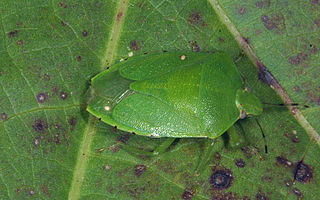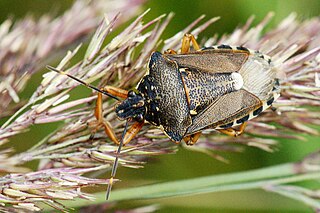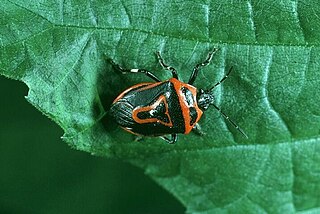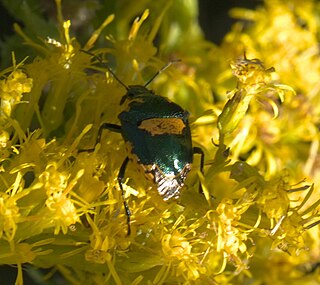
The Pentatomoidea are a superfamily of insects in the Heteroptera suborder of the Hemiptera order. As Hemiptera, they share a common arrangement of sucking mouthparts. The roughly 7000 species under Pentatomoidea are divided into 21 families. Among these are the stink bugs and shield bugs, jewel bugs, giant shield bugs, and burrower bugs.

The western conifer seed bug, often mistakenly referred to as stink bug, sometimes abbreviated as WCSB, is a species of true bug (Hemiptera) in the family Coreidae. It is native to North America west of the Rocky Mountains but has in recent times expanded its range to eastern North America, to include Ontario, Québec, New Brunswick, Nova Scotia, Michigan, Maine, Pennsylvania, New York, Connecticut, Massachusetts, and New Hampshire, and has become an accidental introduced species in parts of Europe and Argentina.

Scutelleridae is a family of true bugs. They are commonly known as jewel bugs or metallic shield bugs due to their often brilliant coloration. They are also known as shield-backed bugs due to the enlargement of the thoracic scutellum into a continuous shield over the abdomen and wings. This latter characteristic distinguishes them from most other families within Heteroptera, and may lead to misidentification as a beetle rather than a bug. These insects feed on plant juices from a variety of different species, including some commercial crops. Closely related to stink bugs, they may also produce an offensive odour when disturbed. There are around 450 species worldwide.

The green stink bug or green soldier bug is a stink bug of the family Pentatomidae.

The brown marmorated stink bug is an insect in the family Pentatomidae, native to China, Japan, Korea, and other Asian regions. In September 1998, it was collected in Allentown, Pennsylvania, where it is believed to have been accidentally introduced. The nymphs and adults of the brown marmorated stink bug feed on over 100 species of plants, including many agricultural crops, and by 2010–11 had become a season-long pest in orchards in the Eastern United States. In 2010, in the Mid-Atlantic United States, $37 million in apple crops were lost, and some stone fruit growers lost more than 90% of their crops. Since the 2010s, the bug has spread to the nation of Georgia and Turkey and caused extensive damage to hazelnut production. It is now established in many parts of North America, and has recently become established in Europe and South America.

Gymnosoma rotundatum is a parasitoid fly found in Europe and Asia.

Nezara viridula, commonly known as the southern green stink bug (USA), southern green shield bug (UK) or green vegetable bug, is a plant-feeding stink bug. Believed to have originated in Ethiopia, it can now be found across the world. Because of its preference for certain species of legumes, such as beans and soybeans, it is an economically important pest on such crops.

Tessaratomidae is a family of true bugs. It contains about 240 species of large bugs divided into 3 subfamilies and 56 genera.

Eysarcoris is a genus of shield bugs belonging to the family Pentatomidae, subfamily Pentatominae, and typical of the tribe Eysarcorini.

Pinthaeus sanguinipes is a species of stink bug.

Cosmopepla lintneriana, the twice-stabbed stink bug, is a species of insect in the family Pentatomidae. Cosmopepla lintneriana was first described in 1798 by Johan Christian Fabricius as Cimex carnifex, and then again in 1865 by Thomas Say as Cosmopepla bimaculata. Cosmopepla lintneriana is hosted by a variety of plants, including milk thistle, echinacea, asparagus, oats, mint and goldenrod, and is widespread throughout North America, from Canada to Mexico. Adult C. lintneriana are black with a red, orange, or yellow band across the pronotum and a short red stripe along the midline, and two red spots at the apex of the scutellum. Nymph coloration ranges from red to white with black markings that change as they grow.

Perillus bioculatus, the two-spotted stink bug or double-eyed soldier bug, is a species of insect in the family Pentatomidae. They are native to North America but have been introduced to Eastern Europe and North India. Both the larval and adult stages are specialized predators of eggs and larvae of the Colorado potato beetle. However, the first instar larvae feed by sucking the juices out of potato stems.

Perillus is a genus of predatory stink bugs in the family Pentatomidae. There are about seven described species in Perillus.

Mormidea lugens is a species of stink bug in the family Pentatomidae found in the Caribbean, Central America, and Eastern North America. In Illinois, adults have been observed emerging from overwintering sites in late April, and continue to be observed until early November, and appear to be bivoltine in this area. Eggs are approximately 0.7 millimetres (0.028 in) in diameter, pale yellow, and laid in small clusters of 6 to 11 eggs. Adults are bronze in color, with a white-yellow border around the scutellum, and are 5.0–7.2 millimetres (0.20–0.28 in) in length. In laboratory conditions, at approximately 24 °C (75 °F), development from eggs to adults has been documented to take between 39 and 50 days, and appears to be affected by the species of host plant. Mormidea lugens has been documented to feed on timothy, sedges, as well as deer-tongue grass, and Bosc's panic-grass. It has been collected from pale sedge and wide-leaved spiderwort but has not observed feeding on these species, and deer-tongue grass appears to be an insufficient food source for development.

Piezodorus guildinii, known generally as red-banded stink bug, is a species of stink bug in the family Pentatomidae. Other common names include the small green stink bug and alfalfa bug.

Stiretrus anchorago, commonly known as the anchor stink bug, is a species of predatory stink bug in the family Pentatomidae. It is found in Central America and North America. It is known to prey upon Epilachna varivestis and Hypera postica.

Proxys punctulatus, the black stink bug, is a species of stink bug in the family Pentatomidae. It is found in the Caribbean Sea, Central America, and North America.
Udonga montana is a species of Pentatomid bug found in parts of Asia. Large populations and aggregations are found during some years and in parts of northeastern India, their outbreaks are associated with the mass flowering of bamboo. They are traditionally collected and eaten in some parts of their range and in Mizoram they are known locally as thangnang and are of some economic value as food and for purported value in traditional cures.

Cyclopelta siccifolia is a bug in the family Dinidoridae found in South Asia. It is known for its large aggregations on certain species of plants. They have been known to aggregate and damage Erythrina, Sesbania, Pongamia, and Cajanus cajan.

Cuspicona simplex, commonly known as the green potato bug, is a herbivorous species of stink bug native to Australia and introduced to New Zealand. It feeds on nightshades. It is primarily known as a pest of potatoes, tomatoes, and other crops in the nightshade family.



















